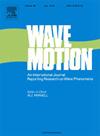Impact of directional spreading on nonlinear KdV-soliton spectra in intermediate water
IF 2.1
3区 物理与天体物理
Q2 ACOUSTICS
引用次数: 0
Abstract
The Korteweg–De Vries (KdV) equation is a partial differential equation used to describe the dynamics of water waves under the assumptions of shallow water, unidirectionality, weak nonlinearity and constant depth. It can be solved analytically with a suitable nonlinear Fourier transform (NFT). The NFT for the KdV equation is subsequently referred to as the KdV-NFT. The soliton part of the nonlinear Fourier spectrum provides valuable insights into the nonlinear evolution of waveforms by exposing the amplitudes and velocities of potentially hidden solitonic components. Under the KdV equation, the nonlinear spectrum evolves trivially according to simple analytic rules. This in particular reflects that solitons are conserved by the KdV equation. However, in reality, the nonlinear spectrum will change during evolution due to deviations from the KdV equation. For example, waves in the ocean are typically multi-directional. Furthermore, the water depth may range into the intermediate regime, e.g. depending on tides and peak periods. It is therefore uncertain how long the nonlinear spectrum of real-world data remains representative. In particular, it is unclear how stable the detected soliton components are during evolution. To assess the effectiveness of the KdV-NFT in representing water wave dynamics under non-ideal conditions, we generated numerical sea states with varying directional spreading in intermediate water () using the High-Order Spectral Ocean (HOS-Ocean) model for nonlinear evolution. After applying the NFT to space series extracted from these evolving directional wave fields, we observe that the KdV-soliton spectra from the NFT are quite stable for cases with small directional spreading. We in particular observe that the largest soliton amplitude is (sometimes dramatically) more stable than the amplitude of the largest linear mode. For large directional spreading, the applicability is limited to short propagation times and distances, respectively.

中间水体中定向扩散对非线性kdv孤子谱的影响
Korteweg-De Vries (KdV)方程是描述浅水、单向性、弱非线性和定深条件下水波动力学的偏微分方程。它可以用合适的非线性傅里叶变换(NFT)解析求解。KdV方程的NFT随后被称为KdV-NFT。非线性傅立叶谱的孤子部分通过揭示潜在隐藏的孤子分量的振幅和速度,为波形的非线性演化提供了有价值的见解。在KdV方程下,非线性谱按照简单的解析规则逐次演化。这特别反映了孤子是由KdV方程守恒的。但在实际中,非线性谱在演化过程中会因偏离KdV方程而发生变化。例如,海洋中的波浪通常是多向的。此外,水深可能在中间范围内,例如取决于潮汐和高峰时期。因此,不确定实际数据的非线性谱能保持多长时间的代表性。特别是,目前还不清楚探测到的孤子成分在演化过程中有多稳定。为了评估KdV-NFT在非理想条件下表征水波动力学的有效性,我们使用高阶谱海洋(HOS-Ocean)非线性演化模型在中间水域(kh=1.036)生成了不同方向扩展的数值海态。将NFT应用于从这些演化的定向波场中提取的空间序列后,我们观察到从NFT中得到的kdv -孤子谱在方向扩展较小的情况下是相当稳定的。我们特别观察到,最大孤子振幅(有时戏剧性地)比最大线性模态的振幅更稳定。对于大方向扩展,其适用性分别限于较短的传播时间和距离。
本文章由计算机程序翻译,如有差异,请以英文原文为准。
求助全文
约1分钟内获得全文
求助全文
来源期刊

Wave Motion
物理-力学
CiteScore
4.10
自引率
8.30%
发文量
118
审稿时长
3 months
期刊介绍:
Wave Motion is devoted to the cross fertilization of ideas, and to stimulating interaction between workers in various research areas in which wave propagation phenomena play a dominant role. The description and analysis of wave propagation phenomena provides a unifying thread connecting diverse areas of engineering and the physical sciences such as acoustics, optics, geophysics, seismology, electromagnetic theory, solid and fluid mechanics.
The journal publishes papers on analytical, numerical and experimental methods. Papers that address fundamentally new topics in wave phenomena or develop wave propagation methods for solving direct and inverse problems are of interest to the journal.
 求助内容:
求助内容: 应助结果提醒方式:
应助结果提醒方式:


